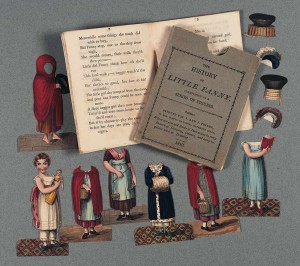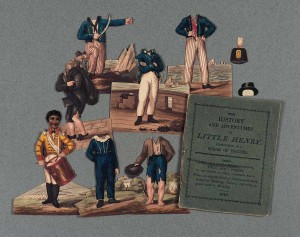Other than your hero/heroine, that is…
 Today I’m talking about paper dolls of the Regency period, but not the fashion figures that originated in France and were adopted by dressmakers and their clients, and their clients’ children in the 1790s. Paper dolls specifically for children were created and published by Samuel and Joseph Fuller in a series of paper doll booklets–figures that dress and undress–and sold at their shop The Temple of Fancy on Rathbone Place in London. Attracting an upperclass clientele, the shop also sold prints and painting materials and supplies.
Today I’m talking about paper dolls of the Regency period, but not the fashion figures that originated in France and were adopted by dressmakers and their clients, and their clients’ children in the 1790s. Paper dolls specifically for children were created and published by Samuel and Joseph Fuller in a series of paper doll booklets–figures that dress and undress–and sold at their shop The Temple of Fancy on Rathbone Place in London. Attracting an upperclass clientele, the shop also sold prints and painting materials and supplies.
In mediocre rhyme, the books told an improving story with a hand-colored paper doll, outfits only, with a moveable head at the end of the book. Hours of fun and instruction! Here’s an overview of The History of Little Fanny: Exemplified in a Series of Figures (1810) and you can play online paper dolls with Fanny here.
 I have seen a reproduction copy of Little Fanny and the storyline is depressingly moral. Little Fanny is far too interested in clothes and learns the virtues of plain living and hard work. Another title, Ellen, or, The Naughty Girl Reclaimed, pretty much speaks for itself.
I have seen a reproduction copy of Little Fanny and the storyline is depressingly moral. Little Fanny is far too interested in clothes and learns the virtues of plain living and hard work. Another title, Ellen, or, The Naughty Girl Reclaimed, pretty much speaks for itself.
But the boys. Oh, did the boys have fun. How about Frank Feignwell’s Attempts to Amuse His Friends on Twelfth-Night. You can dress and undress flamboyant young Frank here.
And then there’s The History and Adventures of Little Henry.
 Just by looking at this you can see that Henry has a whale of a time, and you can view the book online here. First, he’s stolen by gypsies (moral lesson on inattentive nursemaid included) and becomes a beggar, then a chimney sweep, a drummer boy, and a sailor, rising through the ranks to return to England with fame and fortune. Huzzah!
Just by looking at this you can see that Henry has a whale of a time, and you can view the book online here. First, he’s stolen by gypsies (moral lesson on inattentive nursemaid included) and becomes a beggar, then a chimney sweep, a drummer boy, and a sailor, rising through the ranks to return to England with fame and fortune. Huzzah!
So, yes. Boys can dress up and seek material success in life, but not girls. “The textual morals against love of clothing are gendered in problematic ways, with female characters mortified for this flaw more readily than male characters.” (A Story, Exemplified in a Series of Figures: Paper Doll versus Moral Tale in the Nineteenth Century by Hannah Field. More) And there’s also a great deal of self-satisfaction, one suspects, on the part of the well-heeled patrons of the Fullers’ shop, buying these idealized, smug stories for their own children.
For more online fun, Williamsburg has an online paper doll game and you can find downloadable Regency paper dolls, designed by a historian, at PaperThinPersonas.com.
Did you enjoy paper dolls as a child and/or with your own children?
